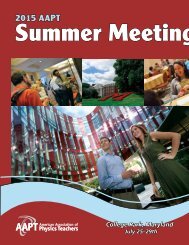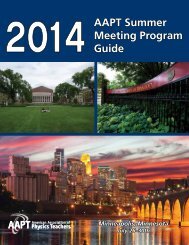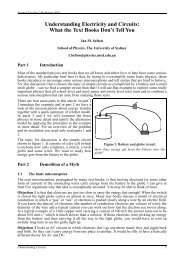final-program-12-23-14-3
final-program-12-23-14-3
final-program-12-23-14-3
Create successful ePaper yourself
Turn your PDF publications into a flip-book with our unique Google optimized e-Paper software.
Session GH: Updates and<br />
Resources for Introductory Physics<br />
for Life Science II<br />
Location: Executive 3A/3B<br />
Date: Tuesday, January 6<br />
Time: 8:30–9:10 a.m.<br />
Presider: Sam Sampere<br />
GH01: 8:30-8:40 a.m. Modifications to the Introductory Lab for<br />
Life Science Majors<br />
Contributed – Erick Agrimson, St. Catherine University, 2004 Randolph<br />
Ave., St. Paul, MN 55105; epagrimson@stkate.edu<br />
Jolene Johnson, St. Catherine University<br />
At St. Catherine University, we have revitalized labs for both the<br />
physics for the health science and the calculus physics courses. The<br />
impetus for the project has been that students have shown great<br />
excitement for biophysical connections in the course and lab. Our<br />
students have consistently commented on how much they enjoy the<br />
laboratory component of our courses. We have started the process of<br />
developing a laboratory manual for both semesters of our courses that<br />
will give voice to many of the biophysical and medical connections<br />
that occur in the second semester of physics courses. We present work<br />
showing examples of new labs that make biophysical connections as<br />
well as revitalized existing labs.<br />
GH02: 8:40-8:50 a.m. Integrating Biological and Biomedical<br />
Topics into Undergraduate Physics Labs<br />
Contributed – Irene Guerinot, Maryville College, 502 E. Lamar Alexander<br />
Pkwy., Maryville, TN 37804; irene.guerinot@maryvillecollege.edu<br />
Pre-health, biology, and exercise science students are required to<br />
take physics courses at Maryville College. The vast majority of these<br />
students pass these courses without making the connection between<br />
physics and many common biological problems, operations, and<br />
techniques. I will present work that we developed to attempt to bridge<br />
Session Sponsors List<br />
AAPT Committees<br />
Apparatus: W30, DD, EI, FC<br />
Educational Technologies: W02, W04, W10,<br />
W28, W30, W34, AC, CD, DA, DF, ED, FC, FE, GF,<br />
TOP02<br />
Graduate Education: DC, GB, TOP04<br />
High Schools: W05, W07, W<strong>12</strong>, W<strong>23</strong>, W33, AE,<br />
BA, BE, CE, DJ, EH, FD<br />
History & Philosophy of Physics: T05, CF, DC,<br />
HB, TOP03<br />
Interests of Senior Physicists: AE, CA<br />
International Physics Education: AI, EC<br />
Laboratories: W21, W31, BG, DG, FB<br />
that gap. The laboratory activities, experiments, and demonstrations<br />
discussed will merge key concepts from at least two of the traditional<br />
disciplines (physics and biology, physics and chemistry, or physics,<br />
biology, and chemistry). Challenges and successes will be discussed.<br />
GH03:<br />
8:50-9 a.m. Osmosis, Colligative Properties, Entropy,<br />
Free Energy and the Chemical Potential*<br />
Contributed – Peter Hugo, Nelson Benedictine University, 5700 College<br />
Rd., Lisle, IL 60532; pete@circle4.com<br />
A diffusive model of osmosis is presented that explains currently<br />
available experimental data. It makes predictions that distinguish it<br />
from the traditional convective flow model of osmosis, some of which<br />
have already been confirmed experimentally and others have yet to be<br />
tested. It also provides a simple kinetic explanation of Raoult’s law and<br />
the colligative properties of dilute aqueous solutions. The diffusive<br />
model explains that when a water molecule jumps from low to high<br />
osmolarity at equilibrium, the free energy change is zero because the<br />
work done pressurizing the water molecule is balanced by the entropy<br />
of mixing. It also explains that equal chemical potentials are required<br />
for particle exchange equilibrium in analogy with the familiar requirement<br />
of equal temperatures at thermal equilibrium. These are topics<br />
that should be considered for inclusion in the redesign of introductory<br />
physics courses for the life sciences (IPLS).<br />
NSF DUE-0836833 http://circle4.com/biophysics<br />
http://www.circle4.com/biophysics/modules/BioPhysMod05.pdf<br />
GH04: 9-9:10 a.m. Measuring Cell Phone Signal: Experiment<br />
for Pre-Life Sciences Students<br />
Contributed – Wathiq Abdul-Razzaq, West Virginia University, Physics<br />
Department, Morgantown, WV 26506; wabdulra@wvu.edu<br />
The inconclusive evidence surrounding the issue of the danger of cell<br />
phone signal should motivate students especially the pre-life sciences<br />
students in binding physics with their field of study. A lab experiment<br />
was developed to measure the intensity of the microwaves emitted by<br />
cell phones and compare it to the intensity limit set up by the FDA<br />
for acceptable human exposure to microwaves. The intensity of microwaves<br />
leaked from microwave oven are also measured and compared<br />
to the cell phone radiation.<br />
Diversity: BD, DJ<br />
Pre-High School Education: W15, AE, BF, CH, EF<br />
Professional Concerns: W17, EB, GB<br />
Research in Physics Education: W13, W27, W34,<br />
CE, CG, DF, DH, EG, GA, GC, TOP04<br />
Science Education for the Public: W31, CA, DB,<br />
EE, EF, FE, TOP01<br />
Space Science and Astronomy: W01, CF, HB<br />
Teacher Preparation: W08, W<strong>23</strong>, BF, DE, EG, EH,<br />
FD, GC, HE<br />
Two-Year Colleges: W04, W<strong>14</strong>, W17, W24, BC,<br />
EA, GD, HA<br />
Undergraduate Education: W04, W<strong>14</strong>, W21,<br />
W32, AA, BB, BG, CC, CG, DG, DI, EE, FB, GE<br />
Women in Physics: W25, BD, CB, EB<br />
Tuesday Morning<br />
January 3–6, 2015<br />
91






